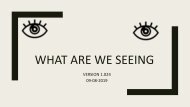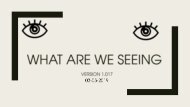You also want an ePaper? Increase the reach of your titles
YUMPU automatically turns print PDFs into web optimized ePapers that Google loves.
Thursday, 22 November 2018 Page 1<br />
For important disclosures please refer to page 15.<br />
Christopher Wood christopher.wood@clsa.com +852 2600 8516<br />
Identity theft and private equity<br />
London<br />
”An asset-deflation cycle remains the biggest risk to the American and world economy after the<br />
surge in asset prices from ten years of ultra-easy monetary policy”. So wrote GREED & fear in one of<br />
the bullet points in the most recent Asia Maxima quarterly (see Asia Maxima – Crossroads, 4Q18).<br />
GREED & fear says this not in the spirit of “I told you so”. But rather to note that the current state of<br />
affairs is the opposite of what is taught in economic textbooks (i.e. asset prices and financial markets<br />
will drive the economy and not the other way round). This is a point worth highlighting again given<br />
the renewed weakness of Wall Street-correlated world stock markets despite GREED & fear’s<br />
continuing hopes of a trade deal between America and China in the G20 Summit in Buenos Aires on<br />
30 November. The MSCI AC World Index is now down 7.2% in US dollar terms year-to-date and the<br />
American stock market is no longer “the last man standing” as it was at the end of last quarter (see<br />
Figure 1). The S&P500 is down 0.9% year-to-date while the Nasdaq is up only 1%. But more<br />
interestingly, three of the four FANG stocks have now suffered the dreaded “death cross” in the<br />
sense that the 50-day moving average has fallen below the 200-day moving average (see Figure 2).<br />
Amazon is the exception.<br />
Figure 1<br />
S&P500 and MSCI AC World Index<br />
18 (%YTD)<br />
15<br />
12<br />
9<br />
6<br />
3<br />
0<br />
-3<br />
Nasdaq Composite<br />
-6<br />
S&P500<br />
-9<br />
MSCI AC World Index<br />
-12<br />
MSCI AC World ex-US<br />
-15<br />
Jan 18 Feb 18 Mar 18 Apr 18 May 18 Jun 18 Jul 18 Aug 18 Sep 18 Oct 18 Nov 18<br />
Source: CLSA, Datastream<br />
Still GREED & fear also noted in the above mentioned bullet point that for that asset-deflation cycle<br />
really to happen requires “a financial shock triggered by rising credit spreads and forced selling”. So<br />
far credit spreads remain relatively well behaved. Still there is no doubt where the risk in credit is in<br />
the US. It is in corporate debt where the deterioration in quality is best shown by the huge growth in<br />
triple-B debt as a percentage of the aggregate of corporate debt issued. US BBB-rated corporate<br />
bond outstanding has risen from US$670bn or 33% of total US investment-grade corporate bonds at<br />
the end of 2008 to US$2.5tn or 50% of the total at present, based on constituents in the<br />
Bloomberg-Barclays US Corporate Bond Index (see Figure 3).
















